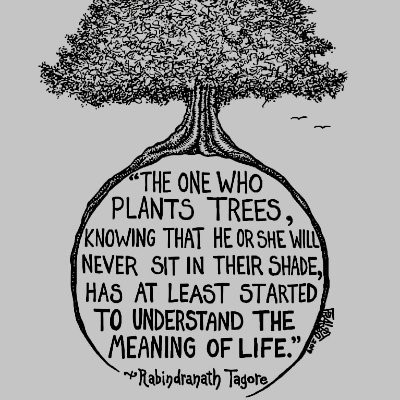The Multiple Benefits of Trees

Our core aim at Stump Up For Trees is ecological restoration, bringing nature back to South Wales and the Bannau Brycheiniog. We absolutely believe that increased tree cover for the purpose of nature restoration can be done in ways that are led by and support the local agricultural community. One of the reasons for this is that the multiple benefits of trees means that whether or not you agree about the primary purpose for planting a tree, you can definitely benefit from them.
So, key questions:
- What are the multiple benefits of trees, above and beyond their role in habitat restoration and biodiversity?
- How will our sites, planted this winter, leverage these benefits?
Well, I’m pretty sure there’s a book in answering question a, but here are a few examples, and places where you can go and find out more information:
- Health and Wellbeing
- Air Quality and temperature moderation (see also)
- Water Quality
- Carbon sequestration
- Flood mitigation and drought moderation
- Livestock shelter and forage
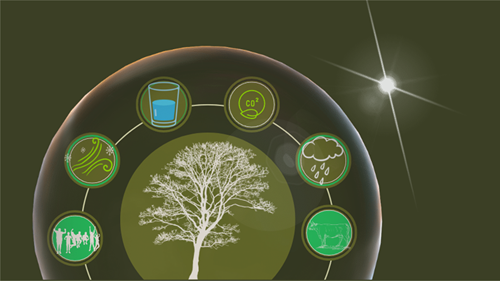
Second question: How does Stump Up For Trees leverage these multiple benefits?
Over the next few months we’ll be updating the case studies on our website, and for each of these sites we’ll go into a bit of detail about why and how the increased tree cover will provide multiple benefits. To get you started here are a few examples:
Air quality and temperature moderation – whilst we don’t plant in urban areas, the importance of tree cover in providing shade and reducing temperature has been identified as key, particularly near water sources. One of our sites, Pant Y Pwll, for example, included planting on the riverbank – this additional shade will help keep the temperature of the watercourse down, really key for supporting the diversity in the river. Once known as a trout stream, this could support regeneration and recovery as well as ensuring resilience with increasing temperatures. This has to be a balance of course, light is equally important on a riverbank, but at the moment the tree cover on the Trothy is low, and predominantly older trees at the end of their lifespan, new planting will be key in ensuring it’s continued survival.
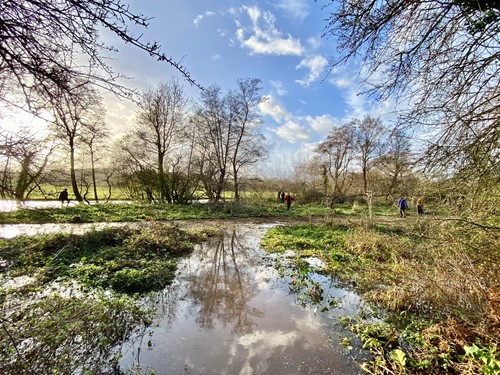
Water quality- we’ve just started working with the Wye and Usk Foundation on their project in the Crai catchment, planting hedgerows, shelterbelts and new woodland at 5 sites across the catchment. By increasing infiltration to groundwater increased tree cover reduces runoff from both infrastructure, fields and agricultural sites, reducing the concentration of pollutants that runs into watercourses.
Carbon Sequestration – Well, this one’s a bit obvious: every single tree planted will sequester carbon over its lifetime. Of course, how much and for how long is incredibly complex; species matter, and it’s often forgotten that management plays a key part in this. Upland trees are likely to grow less fast than, say, a conifer plantation. However, carbon is captured in soils, undergrowth, hummus, as well as the tree itself. A well-managed hedgerow can capture significant carbon, in a laid hedge the tree size (biomass) can be comparative to the fully grown tree. Calculating all of this is cutting-edge science. The importance for us is diversity, resilience and being there for the long term. This winter 31 new sites have entered our long-term monitoring programs, ensuring that all the (92,000!) trees we’ve planted will grow to establishment. That’s a potential (at a conservative estimate specifically for upland trees) 25,300 tC02e sequestered over the next 100 years.
Flood and drought mitigation
Bob Vaughan (our Trustee) and I are putting together a much more detailed piece on this, and as it’s my personal area of expertise, I do have a tendency to wax lyrical, so here is a (very) potted summary. Low-density, diverse (structure and species), and low-impact (minimal impact on soils by planting), catchment-wide planting is absolutely key in flood and potentially drought mitigation and resilience.
Flooding is obvious – increased tree cover reduces run-off (slows the flow both above and below ground), increases infiltration to groundwater and increases evapotranspiration (water being returned to the atmosphere or ‘used’ by the tree). This means flood peaks are reduced with more water being stored in the landscape rather than running off it.
Drought mitigation is more controversial – there is a strong belief that trees will ‘drink all the water’, which is a fair belief but isn’t actually correct. There are really cool things going on, like the fact that different species use different types of water in the ground (even different ‘times’ of water – yes, there’s winter water and spring water, and we can tell the difference). Low-density, mixed species planting uses different sources and depths of water for crops or grassland while also keeping surface temperatures down and, very importantly, reducing evaporation from the ground. This is where wood pasture, mixed mosaic habitats and the magical areas of Coed Cae and Fridd really come into their own.
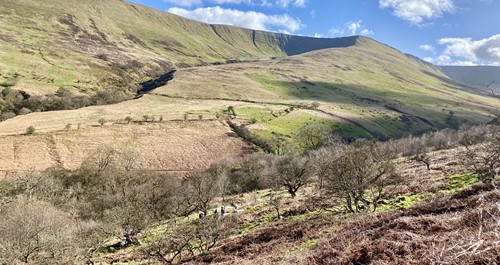
Pentwyn farm will be a fantastic example of this (bonus benefit, but one of our main aims, see in the photo above, how the are areas of grass are under the tree growth, whilst the rest is bracken dominated), with the regenerated Coedcae mitigating both flood and drought. Look out for Rob’s longer post that will talk all about this. However, ANY type of increased tree cover at sensible densities will help – so farmers and landowners should be supported to do whatever works best for them. Which brings me to….
Agriculture and livestock
I really should get Kate to write this, as she loves Hedgerows, Shelterbelts, small copses, and other agroforestry/farm wood features.
Trees provide shelter, forage (eventually, when they’re old enough to cope with a bit of browsing) and an engaging habitat for animals (and other species), whether they’re wild or farmed. For example, hedgerows can really help with stock management, from keeping flocks separate for pathogen management to ensuring suitable cover from high winds and foul weather (yes, it’s Wales) for early lambing ewes.
We’re really proud of our ‘Traditional Boundaries of Wales’ project, in which we partnered with the BBNPA (Bannau Brycheiniog National Park Authority) to create and restore hedgerows in the national park. We’ve also planted with numerous landowners, large and small, outside of the park bringing us to over 8km of hedgerow this season! As two examples, Rachel will be writing about the small holding ‘Home Hill’ in her planting diaries, and Great Tre Rhew farm will be one of our case studies, so watch out for those. We’ve also helped two farms trial small tree copses within fields and we’ll be monitoring these carefully to see how well the species mix does over the next 12 years.
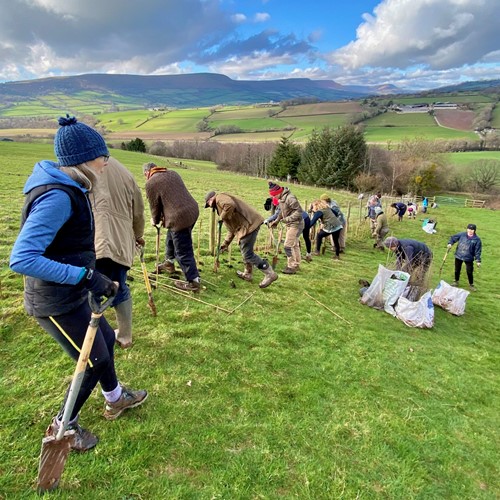
Health and wellbeing
I don’t know about you, but getting out and planting trees was one of the things that made me feel a little better about the world this winter. We’re very fortunate, despite primarily planting on public land, a number of our sites this year have public access via well-maintained footpaths or will have direct community impact (like Nepali Village and Home Hill). For many of our volunteers who haven’t been able to get out on the hills, just being outside at the tree nursery has been a wonderful experience – demonstrating that even tiny trees have benefits!
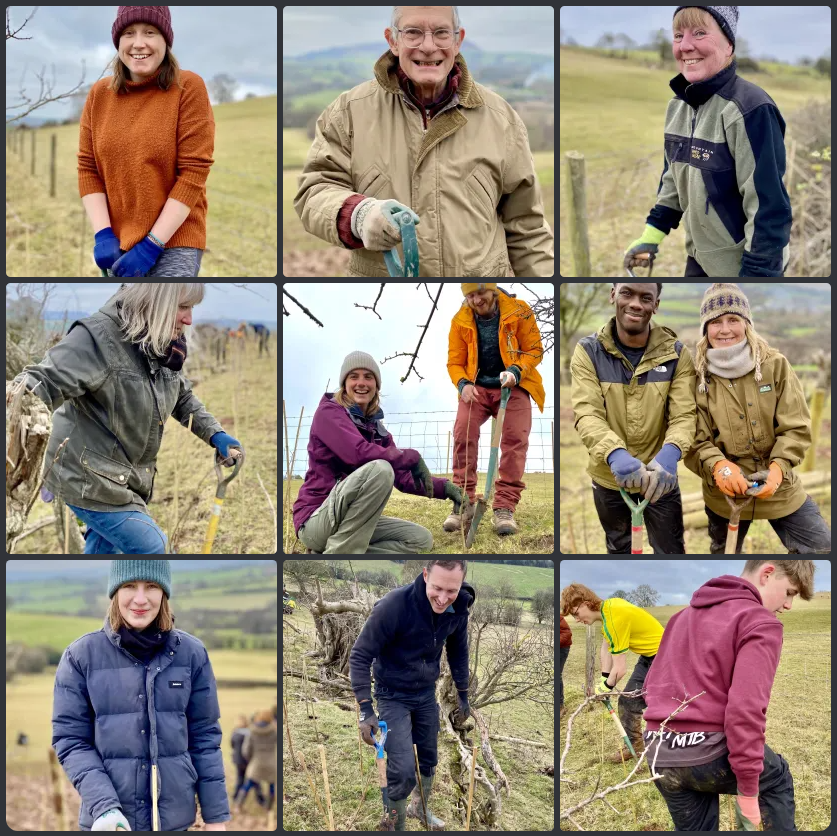
Many of the multiple benefits of the trees we are planting aren’t for us. They’re for our children, our children’s children and honestly, for our love of nature itself. But we can gain the well-being of knowing that we planted them.
